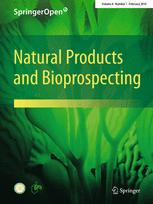|
|
Five New Alkaloids from Cephalotaxus lanceolata and C. fortunei var. alpina
Collect
Ling Ni, Xiu-Hong Zhong, Jie Cai, Mei-Fen Bao, Bing-Jie Zhang, Jing Wu, Xiang-Hai Cai
Natural Products and Bioprospecting. 2016, 6 (3): 149-154.
DOI: 10.1007/s13659-016-0093-7
Five new alkaloids (1-5) were isolated from the leaves and twigs of Cephalotaxus lanceolata and C. fortunei var. alpina along with 24 known alkaloids. The new structures were elucidated based on spectroscopic data including 1D and 2D NMR, FTIR, UV and MS. These new alkaloids showed no cytotoxicity to HeLa, SGC-7901 gastric cancer, and A-549 lung cancer cell lines.
References |
Related Articles |
Metrics
|
|
|
Drimane Sesquiterpenoids and Isochromone Derivative from the Endophytic Fungus Pestalotiopsis sp. M-23
Collect
Ce Kuang, Shu-Xi Jing, Yan Liu, Shi-Hong Luo, Sheng-Hong Li
Natural Products and Bioprospecting. 2016, 6 (3): 155-160.
DOI: 10.1007/s13659-016-0094-6
Three new drimane sesquiterpenoids (1-3) together with the known 2α-hydroxyisodrimeninol (4), and a new isochromone derivative (5), were obtained from the solid cultures of fungal strain Pestalotiopsis sp. M-23, an endophytic fungus isolated from the leaves of Leucosceptrum canum (Labiatae). Their structures were determined by comprehensive 1D and 2D NMR, and MS analyses. The metabolites were evaluated for their antibacterial activities, and compound 3 showed weak inhibitory activity against Bacillus subtilis.
References |
Related Articles |
Metrics
|
|
|
Neolignans from Selaginella moellendorffii
Collect
Jing-Xian Zhuo, Yue-Hu Wang, Xing-Li Su, Ren-Qiang Mei, Jun Yang, Yi Kong, Chun-Lin Long
Natural Products and Bioprospecting. 2016, 6 (3): 161-166.
DOI: 10.1007/s13659-016-0095-5
Two new neolignans selaginellol (1) and selaginellol 4'-O-b-D-glucopyranoside (2), together with seven known compounds (3-9), were isolated from the whole plant of Selaginella moellendorffii. The structures of the new isolates were determined through spectroscopic data analysis. Compounds 1-9, as well as compounds 10-18 previously isolated from the species, were measured for the activity against platelet aggregation induced by ADP or collagen. Three neoligans (8, 11, and 12), one flavanone (14), and one alkaloid (16) showed inhibitory activity against ADP-or collagen-induced platelet aggregation as compared with tirofiban. The dihydrobenzofuran neolignans (8, 11, and 12) are more potent than the benzofuran neolignan (13) and other types of neolignans (1-7). Glucosidation of the dihydrobenzofuran neolignans (11 and 12) is helpful for the activity.
References |
Related Articles |
Metrics
|
|
|
Ypsiyunnosides A-E, Five New Cholestanol Glycosides from Ypsilandra yunnanensis
Collect
Yu Chen, Yong-Ai Si, Wei Ni, Huan Yan, Xu-Jie Qin, Chang-Xiang Chen, Hai-Yang Liu
Natural Products and Bioprospecting. 2016, 6 (3): 173-182.
DOI: 10.1007/s13659-016-0098-2
Phytochemicalinvestigationonthewholeplantsof Ypsilandrayunnanensiswascarriedoutforthefirsttimeandledtothe isolation of five new cholestanol glycosides, ypsiyunnosides A-E (1-5), and one known analogue. Their structures were determined mainly by detailed spectroscopic analysis, including extensive 1D and 2D NMR, MS and UV, as well as chemical methods. Among them, compound 1 possessed a rare 6/6/6/5/5 fused-rings cholestanol sketelon, which was identified as (23R,25R)-3β,16α,26-triol- 16,23-cyclocholest-5,17(20)-dien-22-one. Their induced platelet aggregation activities and cytotoxicities were evaluated.
References |
Related Articles |
Metrics
|
|

